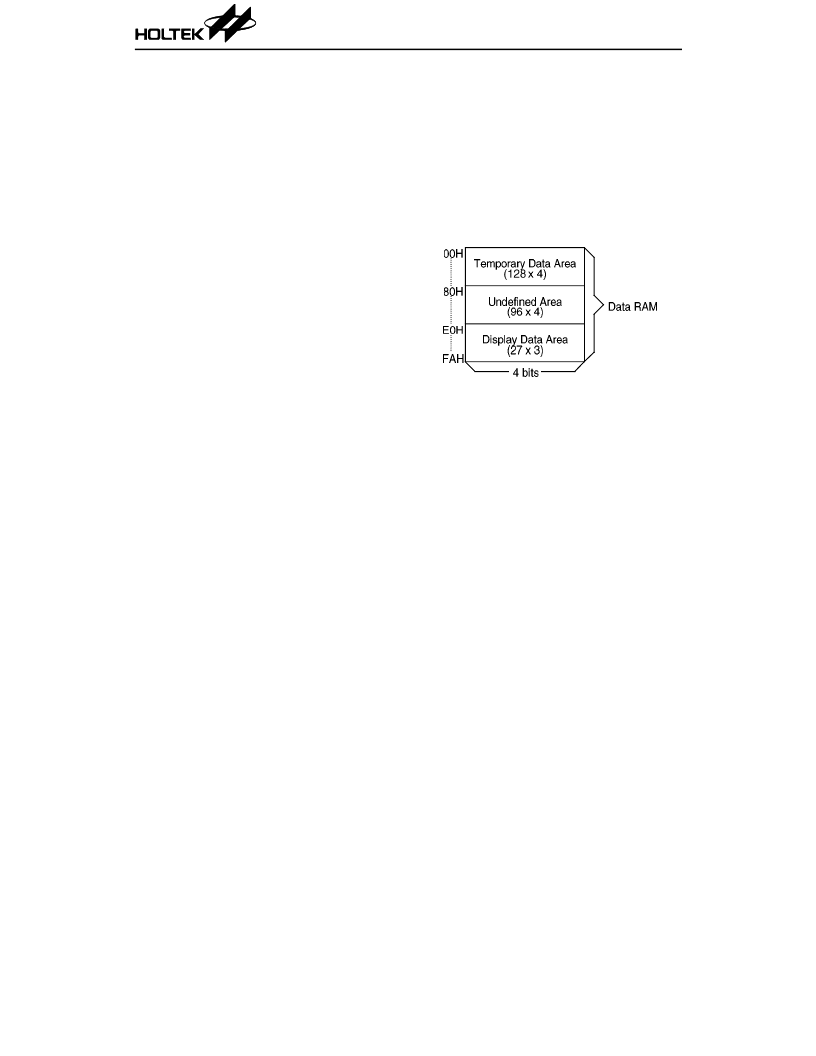- 您現在的位置:買賣IC網 > PDF目錄385408 > HTG1390 (Holtek Semiconductor Inc.) 4-bit Microcontroller PDF資料下載
參數資料
| 型號: | HTG1390 |
| 廠商: | Holtek Semiconductor Inc. |
| 英文描述: | 4-bit Microcontroller |
| 中文描述: | 4位微控制器 |
| 文件頁數: | 8/27頁 |
| 文件大小: | 427K |
| 代理商: | HTG1390 |
第1頁第2頁第3頁第4頁第5頁第6頁第7頁當前第8頁第9頁第10頁第11頁第12頁第13頁第14頁第15頁第16頁第17頁第18頁第19頁第20頁第21頁第22頁第23頁第24頁第25頁第26頁第27頁

Note that the page number n must be greater
than zero as some locations in page 0 are re-
served for specific usage as mentioned. This
area may function as normal program memory
as required.
The program memory mapping is shown in the
diagram.
In the execution of an instruction the program
counter is added before the execution phase, so
careful manipulation of RE AD MR0A and
READ R4A is needed in the page margin.
Stack register
The stack register is a group of registers used to
save the contents of the program counter (PC)
and is arranged in 13 bits
×
1 level. One bit is
used to store the carry flag. An interrupt will
force the contents of the PC and the carry flag
onto the stack register. A subroutine call will
also cause the PC contents to be pushed onto
the stack; however the carry flag will not be
stored. At the end of a subroutine or an inter-
rupt (indicated by a return instruction RE T or
RETI), the contents of the stack register are
returned to the PC.
Executing “RETI” instruction will restore the
carry flag from stack register, but “RET” doesn’t.
Working registers – R0,R1,R2,R3,R4
There are 5 working registers (R0,R1,R2,R3,
R4) usually used to store the frequently ac-
cessed intermediate results. Using the instruc-
tions INC R n and DE C Rn the working
registers can increment (+1) or decrement (–1).
The J NZ Rn (n=0,1,4) instruction makes effi-
cient use of the working registers as a program
loop counter. Also the register pairs R0,R1 and
R2,R3 are used as a data memory pointer when
the memory transfer instruction is executed.
Data memory – RAM
The static data memory (RAM) is arranged in
256
×
4 bit format and is used to store data. All of
the data memory locations are indirectly ad-
dressable through the register pair R1,R0 or
R3,R2; for example MOV A,[R3R2] or MOV
[R3R2],A.
There are two areas in the data memory, the
temporary data area and the display data area.
Access to the temporary data area is from 00H
to 7FH. Locations E 0H to FAH represent the
display data area. The locations between the
temporary and display data areas are unde-
fined and cannot be used.
When data is written into the display data area
it is automatically read by the LCD driver
which then generates the corresponding LCD
driving signals.
Accumulator – ACC
The accumulator is the most important data
register in the processor. It is one of the sources
of input to the ALU and the destination of the
results of the operations performed in the ALU.
Data to and from the I/O ports and memory also
passes through the accumulator.
Arithmetic and logic unit – ALU
This circuit performs the following arithmetic
and logical operations ...
Add with or without carry
Subtract with or without carry
AND, OR, E xclusive-OR
Rotate right, left through carry
BCD decimal adjust for addition
Increment, decrement
Data transfers
Branch decisions
The ALU not only outputs the results of data
operations, but also sets the status of the carry
flag (CF) in some instructions.
Data memory
HTG1390
Preliminary
8
17th Nov ’98
相關PDF資料 |
PDF描述 |
|---|---|
| HTG1395 | 3-in-1 LCD Game |
| HTG2150 | 8-Bit 320 Pixel LCD Microcontroller |
| HTG2190 | 8-Bit 1024 Pixel LCD Microcontroller |
| HTIP117D | PNP EPITAXIAL PLANAR TRANSISTOR |
| HTM1505 | RELATIVE HUMIDITY AND TEMPERATURE MODULE |
相關代理商/技術參數 |
參數描述 |
|---|---|
| HTG1395 | 制造商:HOLTEK 制造商全稱:Holtek Semiconductor Inc 功能描述:3-in-1 LCD Game |
| HTG13A0 | 制造商:未知廠家 制造商全稱:未知廠家 功能描述:4-Bit Microcontroller |
| HTG13B0 | 制造商:未知廠家 制造商全稱:未知廠家 功能描述:4-Bit Microcontroller |
| HTG13J0 | 制造商:HOLTEK 制造商全稱:Holtek Semiconductor Inc 功能描述:4-Bit Microcontroller |
| HTG13Q0 | 制造商:未知廠家 制造商全稱:未知廠家 功能描述:4-Bit Microcontroller |
發(fā)布緊急采購,3分鐘左右您將得到回復。